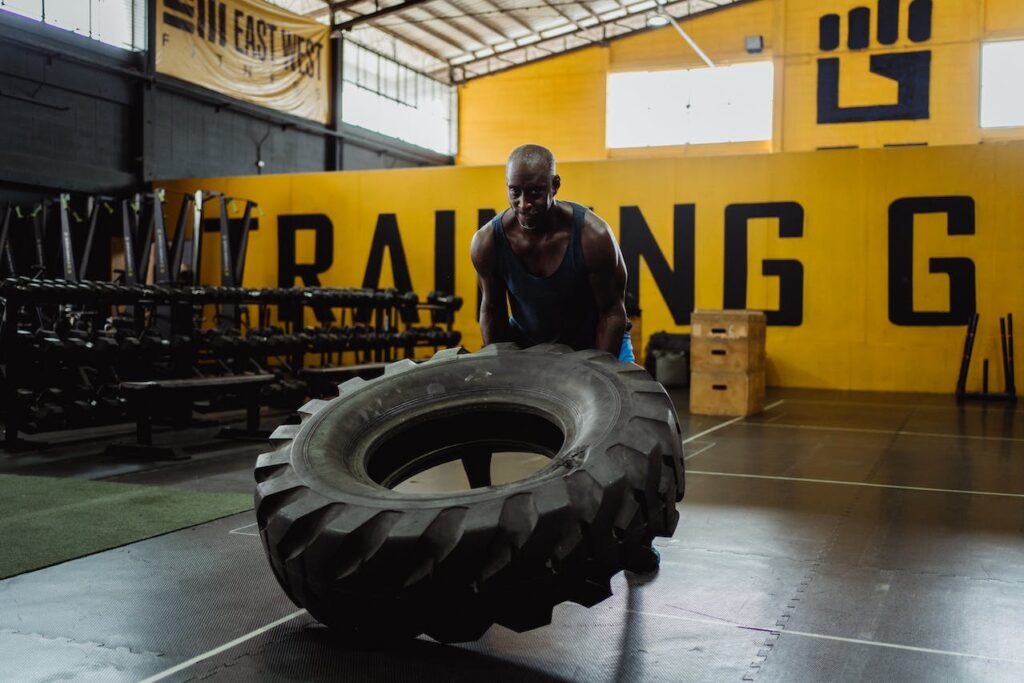Do you know the tire flips exercise? It’s a strong workout that uses many muscles in your body. Tire flips strengthen your legs, glutes, core, upper body, and grip. Your legs work hard in this exercise. Your quadriceps, hamstrings, and calves help lift the tire.
Your buttocks muscles give power for lifting and flipping. Your abs and back keep your body stable. Your shoulders, chest, arms, and back help you grip and push the tire. Your hands and forearms hold the tire tight.

Photo by Ketut Subiyanto
This exercise is tough but can give great results. Good form is important to avoid getting hurt and to get the most from tire flips. For a full guide on tire flips, read the whole post.
#1 Quadriceps
The quadriceps are vital for tire flips. These muscles are at the front of your thigh. In tire flips, quadriceps are the main muscles for the first move to lift the tire. When you start, you bend your knees and hips.
This position puts your quadriceps to work. It helps you push the ground away and lift the tire. As you stand up with the tire, your quadriceps work even harder.
#2 Hamstrings and Glutes
Hamstrings and glutes work together in tire flips. Hamstrings are at the back of your thighs. Glutes are your buttock muscles. These muscles are important for hip movement.
When you lift and flip the tire, your hips move forward. The hamstrings and glutes make this movement happen. Helps you stand up straight from a squat. This action is crucial for lifting the tire off the ground and moving it forward.
#3 Calves
Calves are the muscles at the back of your lower leg. In tire flips, calves are important for the final push. They work when you press through your toes.
This helps generate force to lift and flip the tire. Calves help you keep balance and power through the exercise. They are key for the explosive movement needed to complete the flip.
#4 Adductors
Adductors are the muscles inside your thighs. They play a role in stabilizing your legs during tire flips. When you lift the tire, your legs must stay stable. Adductors keep your legs from moving too much to the sides.
It also prevents injury and helps with effective lifting.
#5 Rectus Abdominis and Obliques
Rectus abdominis and obliques are your core muscles. Rectus abdominis is at the front of your belly. Obliques are on the sides.
In tire flips, these muscles work hard. They keep your body stable. They also transfer force between your upper and lower body. When you lift and flip the tire, your core muscles keep your spine safe. They also help you use power from your legs and back effectively.
#6 Erector Spinae
Erector spinae are the muscles along your spine. They are important for keeping a good back position in tire flips. These muscles help you keep your back straight and safe.
When you lift the tire, it’s important not to round your back. Erector spinae muscles prevent this. This protects your spine and makes your lifting stronger.
#7 Upper Back (Trapezius, Rhomboids)
Trapezius and rhomboids in the upper back are crucial for tire flips. These muscles stabilize shoulder blades during the initial lift and flip of the tire. Stabilizing shoulder blades ensures a safe and effective pull. As the tire rises from the ground, these upper back muscles engage to support the movement. Their strength is key to maintaining good posture and avoiding strain.
#8 Biceps and Forearm Muscles
Biceps in the front of upper arms and forearm muscles play a significant role in tire flips. These muscles enable a firm grip on the tire, essential for lifting and controlling it. During the pulling phase of the lift, biceps and forearms engage actively.
The grip and pull by these muscles are fundamental to lifting the tire off the ground.
#9 Triceps
Triceps, located at the back of the upper arms, are involved in the pushing phase of tire flips. As arms extend to drive the tire over, triceps activate. This muscle group is responsible for straightening the arms, crucial for effectively pushing and flipping the tire.
#10 Latissimus Dorsi
Latissimus dorsi, large muscles in the back, are engaged in tire flips. These muscles assist in pulling the tire off the ground and in the flipping motion. The activation of latissimus dorsi is essential for a powerful lift. It ensures the back muscles contribute effectively throughout the exercise.
FAQ
What is the primary muscle group used in tire flips?
The primary muscle group used in tire flips includes the quadriceps, which are key for the initial lift of the tire.
How do tire flips benefit the core muscles?
Tire flips heavily engage core muscles, including the rectus abdominis and obliques, to maintain stability and transfer force between the upper and lower body.
Are the arms and upper body also worked out during tire flips?
Yes, tire flips work out the arms and upper body, including the biceps, triceps, and upper back muscles like the trapezius and rhomboids.
Do tire flips help in strengthening the back?
Tire flips strengthen the back, especially the erector spinae along the spine and the latissimus dorsi, which are vital for lifting and flipping motions.
Can tire flips improve grip strength?
Yes, tire flips can significantly improve grip strength as the biceps and forearm muscles are engaged to grip and lift the tire.
Are lower body muscles like calves and hamstrings worked during tire flips?
Tire flips involve lower body muscles such as calves, which help generate lifting force, and hamstrings, which aid in hip extension during the lift.
Is it important to have good form while doing tire flips?
Yes, maintaining good form is crucial in tire flips to engage the correct muscles effectively and to prevent injury.